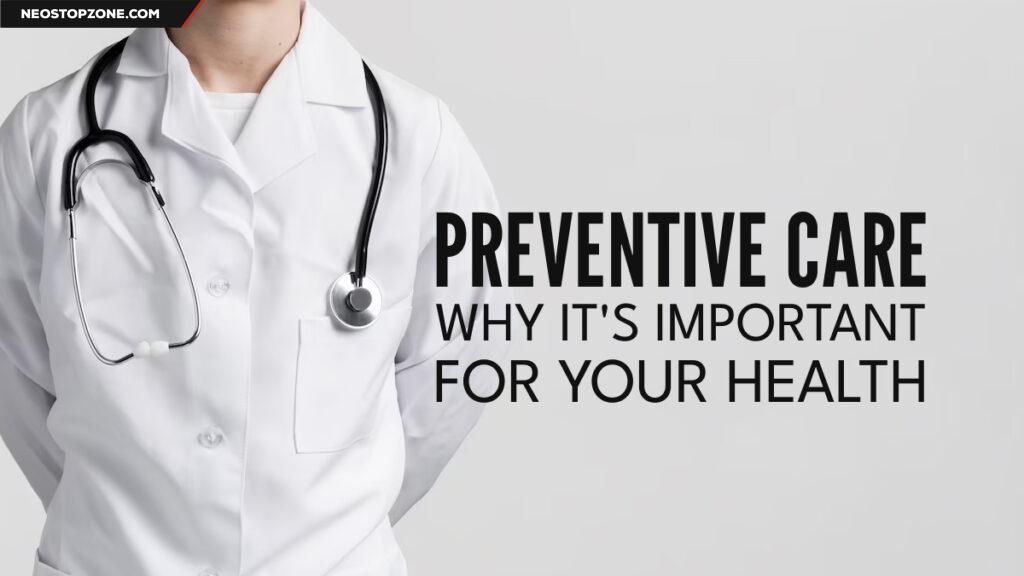
Preventive care plays a crucial role in maintaining and improving our overall health. By focusing on early detection, disease prevention, and lifestyle modifications, preventive care empowers individuals to take control of their well-being and avoid potential health risks. In this article, we will explore the importance of preventive care, its benefits, key components, and how it contributes to the overall health of individuals across different age groups.
I. Introduction
Our health is our most valuable asset, and proactive measures to prevent illness and promote well-being are essential. Preventive care encompasses a range of medical services, screenings, and lifestyle practices aimed at identifying and addressing health issues before they become major concerns. By prioritizing preventive care, individuals can lead healthier lives, minimize healthcare expenses, and enhance their quality of life.
II. Understanding Preventive Care
Preventive care can be defined as the set of healthcare services and interventions aimed at preventing illness, detecting health conditions in their early stages, and promoting healthy behaviors. Its primary objectives include reducing the risk of disease, identifying health issues before symptoms manifest, and guiding individuals towards appropriate interventions for better health outcomes.
III. Benefits of Preventive Care
A. Early Detection of Health Issues
Regular preventive care enables healthcare professionals to identify potential health problems at an early stage. Through screenings, physical examinations, and diagnostic tests, conditions such as high blood pressure, diabetes, or cancer can be detected before symptoms appear. Early detection enhances the effectiveness of treatments, increases survival rates, and improves overall health outcomes.
B. Cost Savings
Investing in preventive care can lead to significant cost savings in the long run. By addressing health issues early on, individuals can avoid more expensive treatments and hospitalizations that may be required if conditions progress undetected. Preventive care also reduces the financial burden on healthcare systems, insurance providers, and individuals, making healthcare more affordable and accessible.
C. Improved Quality of Life
Preventive care promotes proactive health management, helping individuals maintain optimal physical and mental well-being. By focusing on preventive measures, individuals can adopt healthy lifestyle practices, manage chronic conditions effectively, and minimize the impact of potential health risks on their day-to-day lives. This leads to an improved overall quality of life and the ability to engage in activities that bring joy and fulfillment.
D. Reduced Healthcare Burden
By emphasizing prevention, healthcare resources can be allocated more efficiently. Preventive care reduces the burden on healthcare systems by minimizing the need for costly and extensive treatments for advanced diseases. This allows healthcare professionals to focus on early intervention, education, and the overall well-being of their patients.
IV. Key Components of Preventive Care
Preventive care encompasses various components that contribute to overall health maintenance and disease prevention. These components include regular check-ups and screenings, vaccinations and immunizations, and adopting healthy lifestyle practices.
A. Regular Check-ups and Screenings
Routine visits to healthcare providers are essential for preventive care. Regular check-ups allow healthcare professionals to assess an individual’s overall health, monitor vital signs, and identify any potential health concerns. Screenings for conditions such as high blood pressure, cholesterol levels, diabetes, and certain cancers enable early detection and timely intervention.
B. Vaccinations and Immunizations
Vaccinations and immunizations are fundamental preventive measures that protect against infectious diseases. By ensuring timely immunizations, individuals can safeguard themselves and their communities from diseases such as influenza, hepatitis, measles, and more. Vaccinations are particularly crucial for vulnerable populations, including infants, children, and older adults.
C. Healthy Lifestyle Practices
Adopting a healthy lifestyle is vital for preventive care. Engaging in regular physical activity, maintaining a balanced diet, managing stress, avoiding tobacco and excessive alcohol consumption, and getting adequate sleep are all key elements of a healthy lifestyle. These practices contribute to overall well-being, reduce the risk of chronic diseases, and enhance the body’s natural defenses against illnesses.
V. Preventive Care for Different Age Groups
Preventive care requirements differ across various age groups, taking into account the specific health risks and needs associated with each stage of life. Let’s explore the preventive care measures recommended for different age groups:
A. Infants and Children
For infants and children, preventive care involves regular well-child visits, growth monitoring, and vaccinations according to the recommended immunization schedule. These visits allow healthcare providers to track developmental milestones, address parental concerns, and administer necessary vaccinations to protect against diseases.
B. Adolescents and Young Adults
Preventive care for adolescents and young adults emphasizes health promotion, risk assessment, and early intervention. Regular check-ups enable healthcare providers to address concerns related to puberty, mental health, reproductive health, and substance abuse. Vaccinations, such as HPV and meningococcal vaccines, are also recommended during this stage.
C. Adults
Preventive care for adults focuses on maintaining overall health, preventing chronic diseases, and managing existing conditions. Regular check-ups, screenings for hypertension, cholesterol levels, diabetes, and certain cancers, along with vaccinations such as influenza and pneumococcal vaccines, form a crucial part of preventive care for adults.
D. Older Adults
As individuals age, preventive care becomes increasingly important for managing health conditions and maintaining independence. Regular screenings for chronic conditions, osteoporosis, breast and colon cancer, along with vaccinations such as shingles and influenza vaccines, are recommended for older adults. Additionally, fall prevention strategies and cognitive health assessments are vital components of preventive care for this age group.
VI. Common Preventive Care Measures
Preventive care encompasses several common measures that individuals should consider incorporating into their healthcare routine. Let’s explore some of these measures:
A. Routine Physical Examinations
Regular physical examinations are essential for preventive care. During these examinations, healthcare providers assess overall health, perform screenings, check vital signs, and address any concerns. Physical examinations help identify potential health issues early on, allowing for timely intervention and treatment.
B. Blood Pressure and Cholesterol Screenings
Screenings for blood pressure and cholesterol levels are vital components of preventive care. High blood pressure and abnormal cholesterol levels can lead to heart disease, stroke, and other serious health problems. Regular screenings enable early detection, facilitating appropriate interventions and lifestyle modifications.
C. Cancer Screenings
Cancer screenings play a crucial role in preventive care. Depending on an individual’s age and sex, screenings for breast, cervical, colorectal, and prostate cancers are recommended. Early detection of cancer significantly improves treatment outcomes and increases survival rates.
D. Immunizations and Vaccinations
Immunizations and vaccinations are essential preventive measures against infectious diseases. Vaccines protect individuals from illnesses such as influenza, hepatitis, human papillomavirus (HPV), and pneumococcal infections. Staying up to date with recommended immunizations is crucial for maintaining overall health and preventing the spread of contagious diseases.
VII. Promoting Preventive Care
Promoting preventive care requires a multifaceted approach involving education, awareness campaigns, and policy changes. Let’s explore some strategies for promoting preventive care:
A. Education and Awareness Campaigns
Educating individuals about the importance of preventive care and empowering them with knowledge about healthy lifestyle practices are key components of promoting preventive care. Awareness campaigns can include disseminating information through various channels, such as healthcare providers, schools, workplaces, and media platforms.
B. Health Insurance Coverage
Ensuring adequate health insurance coverage for preventive care services is crucial. Health insurance policies should cover preventive care visits, screenings, and immunizations without imposing financial burdens on individuals. Making preventive care accessible and affordable encourages more individuals to prioritize their health.
C. Encouraging a Healthy Lifestyle
Promoting a healthy lifestyle is integral to preventive care. Encouraging regular physical activity, providing access to nutritious food options, and supporting mental well-being initiatives contribute to the overall health of individuals. Collaborative efforts involving healthcare providers, community organizations, and policymakers can create environments that foster healthy behaviors.
VIII. Overcoming Barriers to Preventive Care
Despite the numerous benefits of preventive care, several barriers can hinder its widespread adoption. Let’s explore some common barriers and potential solutions:
A. Lack of Access to Healthcare
Limited access to healthcare services can prevent individuals from seeking preventive care. Efforts should be made to increase healthcare access, particularly for underserved populations, through measures such as community health clinics, telemedicine, mobile healthcare units, and healthcare policies that prioritize preventive care.
B. Financial Constraints
Financial constraints can discourage individuals from seeking preventive care due to concerns about out-of-pocket expenses. Expanding health insurance coverage for preventive care services, implementing subsidies or reduced-cost programs, and promoting employer-sponsored wellness programs can help overcome financial barriers.
C. Fear and Misinformation
Fear and misinformation can create hesitancy or resistance towards preventive care measures. Addressing these concerns requires comprehensive education campaigns, clear communication of the benefits of preventive care, and debunking common misconceptions through trusted sources such as healthcare professionals and public health organizations.
IX. Conclusion
Prioritizing preventive care is essential for maintaining and improving overall health. By emphasizing early detection, disease prevention, and healthy lifestyle practices, individuals can proactively manage their well-being, reduce healthcare costs, and enhance their quality of life. Incorporating preventive care measures at every stage of life, following recommended screenings and vaccinations, and adopting a healthy lifestyle are key steps towards a healthier future.
FAQs
- What is preventive care? Preventive care refers to healthcare services and interventions aimed at preventing illness, detecting health conditions early, and promoting healthy behaviors. It includes regular check-ups, screenings, vaccinations, and lifestyle practices that help individuals maintain optimal health.
- Why is preventive care important? Preventive care is important because it allows for early detection and intervention, reduces healthcare costs, improves quality of life, and reduces the burden on healthcare systems. By focusing on prevention, individuals can lead healthier lives and minimize the risk of developing chronic diseases.
- What are some common preventive care measures? Common preventive care measures include routine physical examinations, blood pressure and cholesterol screenings, cancer screenings, and immunizations. These measures help identify potential health issues, manage risk factors, and protect against infectious diseases.
- Is preventive care different for different age groups? Yes, preventive care requirements vary across different age groups. Infants and children have specific vaccination schedules, while adults and older adults may require screenings for chronic diseases. Preventive care for adolescents focuses on risk assessment and health promotion.
- How can barriers to preventive care be overcome? Barriers to preventive care, such as lack of access and financial constraints, can be addressed through measures like increasing healthcare access, expanding insurance coverage, and implementing educational campaigns. Overcoming fear and misinformation requires clear communication and trusted sources of information.
